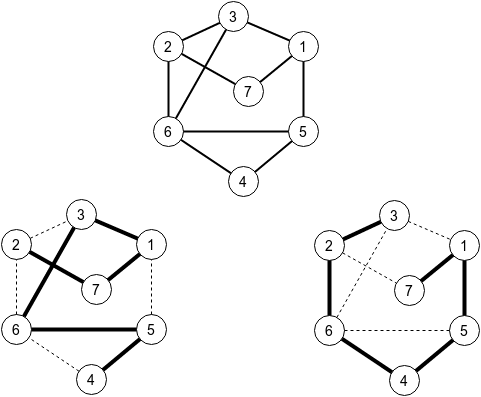Bearland has n cities, numbered 1 through n. Cities are connected via bidirectional roads. Each road connects two distinct cities. No two roads connect the same pair of cities.
Bear Limak was once in a city a and he wanted to go to a city b. There was no direct connection so he decided to take a long walk, visiting each city exactly once. Formally:
- There is no road between a and b.
- There exists a sequence (path) of n distinct cities v1, v2, ..., vn that v1 = a, vn = b and there is a road between vi and vi + 1 for
 .
.
On the other day, the similar thing happened. Limak wanted to travel between a city c and a city d. There is no road between them but there exists a sequence of n distinct cities u1, u2, ..., un that u1 = c, un = d and there is a road between ui and ui + 1 for  .
.
Also, Limak thinks that there are at most k roads in Bearland. He wonders whether he remembers everything correctly.
Given n, k and four distinct cities a, b, c, d, can you find possible paths (v1, ..., vn) and (u1, ..., un) to satisfy all the given conditions? Find any solution or print -1 if it's impossible.
The first line of the input contains two integers n and k (4 ≤ n ≤ 1000, n - 1 ≤ k ≤ 2n - 2) — the number of cities and the maximum allowed number of roads, respectively.
The second line contains four distinct integers a, b, c and d (1 ≤ a, b, c, d ≤ n).
Print -1 if it's impossible to satisfy all the given conditions. Otherwise, print two lines with paths descriptions. The first of these two lines should contain n distinct integers v1, v2, ..., vn where v1 = a and vn = b. The second line should contain n distinct integers u1, u2, ..., unwhere u1 = c and un = d.
Two paths generate at most 2n - 2 roads: (v1, v2), (v2, v3), ..., (vn - 1, vn), (u1, u2), (u2, u3), ..., (un - 1, un). Your answer will be considered wrong if contains more than k distinct roads or any other condition breaks. Note that (x, y) and (y, x) are the same road.
7 11
2 4 7 3
2 7 1 3 6 5 4
7 1 5 4 6 2 3
1000 999
10 20 30 40
-1
In the first sample test, there should be 7 cities and at most 11 roads. The provided sample solution generates 10 roads, as in the drawing. You can also see a simple path of length n between 2 and 4, and a path between 7 and 3.

题目链接:http://codeforces.com/contest/673/problem/D
题意:n个点,m条边的一个图。是否有一条a到b,一条c到d的路径,这两条路径经过所有的点,并且a不能直接到达b,c不能直接到达d。存在这样的图输出两条路径,不存在就输出-1。
思路:

如图所示,构造图。边的数目至少为n+1。当n为4时不符合情况。
代码:
#include <bits/stdc++.h> using namespace std; int sign[2000]; int main() { int i,n,k; int a,b,c,d; int gg; memset(sign,0,sizeof(sign)); cin>>n>>k; cin>>a>>b>>c>>d; sign[a]=sign[b]=sign[c]=sign[d]=1; if(n==4) cout<<"-1"<<endl; else if(k>=n+1) { for(i=1; i<=n; i++) if(sign[i]==0) { gg=i; sign[gg]=1; break; } cout<<a<<" "; for(i=1; i<=n; i++) if(sign[i]==0) cout<<i<<" "; cout<<c<<" "<<gg<<" "<<d<<" "<<b<<endl; cout<<c<<" "; for(i=n; i>=1; i--) if(sign[i]==0) cout<<i<<" "; cout<<a<<" "<<gg<<" "<<b<<" "<<d<<endl; } else cout<<"-1"<<endl; return 0; }